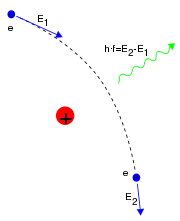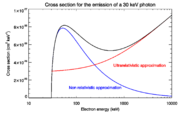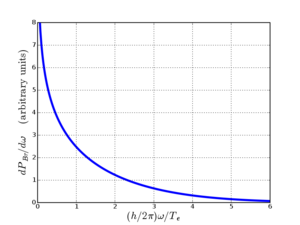Bremsstrahlung

Bremsstrahlung (pronounced [ˈbʁɛmsˌʃtʁaːlʊŋ], from German bremsen "to brake" and Strahlung "radiation", i.e. "braking radiation" or "deceleration radiation"), is electromagnetic radiation produced by the deceleration of a charged particle, such as an electron, when deflected by another charged particle, such as an atomic nucleus. The term is also used to refer to the process of producing the radiation. Bremsstrahlung has a continuous spectrum. The phenomenon was discovered by Nikola Tesla during high frequency research he conducted between 1888 and 1897.
Bremsstrahlung may also be referred to as free-free radiation. This refers to the radiation that arises as a result of a charged particle that is free both before and after the deflection (acceleration) that causes the emission. Strictly speaking, bremsstrahlung refers to any radiation due to the acceleration of a charged particle, which includes synchrotron radiation; however, it is frequently used (even when not speaking German) in the more narrow sense of radiation from electrons stopping in matter.
The word Bremsstrahlung is retained from the original German to describe the radiation which is emitted when electrons are decelerated or "braked" when they are fired at a metal target. Accelerated charges give off electromagnetic radiation, and when the energy of the bombarding electrons is high enough, that radiation is in the x-ray region of the electromagnetic spectrum. It is characterized by a continuous distribution of radiation which becomes more intense and shifts toward higher frequencies when the energy of the bombarding electrons is increased.

Contents |
Outer Bremsstrahlung
"Outer bremsstrahlung" is the term applied in cases where the energy loss by radiation greatly exceeds that by ionization as a stopping mechanism in matter. This is seen clearly for electrons with energies above 50 keV.
Inner Bremsstrahlung
"Inner bremsstrahlung" is the term applied to the less frequent case of radiation emission during beta decay, resulting in the emission of a photon of energy less than or equal to the maximum energy available in the nuclear transition. Inner bremsstrahlung is caused by the abrupt change in the electric field in the region of the nucleus of the atom undergoing decay, in a manner similar to that which causes outer bremsstrahlung. In electron and positron emission the photon's energy comes from the electron/nucleon pair, with the spectrum of the bremsstrahlung decreasing continuously with increasing energy of the beta particle. In electron capture the energy comes at the expense of the neutrino, and the spectrum is greatest at about one third of the normal neutrino energy, reaching zero at zero energy and at normal neutrino energy.
Beta particle emitting substances sometimes exhibit a weak radiation with continuous spectrum that is due to both outer and inner bremsstrahlung, or to one of them alone.
Secondary radiation
Bremsstrahlung is a type of "secondary radiation", in that it is produced as a result of stopping (or slowing) the primary radiation (beta particles). In some cases, e.g. 32P, the Bremsstrahlung produced by shielding this radiation with the normally used dense materials (e.g. lead) is itself dangerous; in such cases, shielding must be accomplished with low density materials, e.g. Plexiglass (lucite), plastic, wood, or water [1]; because the rate of deceleration of the electron is slower, the radiation given off has a longer wavelength and is therefore less penetrating.
Dipole Radiation
Suppose that a particle of charge  experiences an acceleration
experiences an acceleration  which is collinear with its velocity
which is collinear with its velocity  (this is the relevant case for linear accelerators). Then, the relativistic expression for the angular distribution of the bremsstrahlung (considering only the dominant dipole radiation contribution), is
(this is the relevant case for linear accelerators). Then, the relativistic expression for the angular distribution of the bremsstrahlung (considering only the dominant dipole radiation contribution), is
-
 ,
,
- where
 and
and  is the angle between
is the angle between  and the point of observation.
and the point of observation.
Integrating over all angles then gives the total power emitted as [1]
-
 ,
,
where  is the Lorentz factor .
is the Lorentz factor .
The general expression for the total radiated power is[2]
where  signifies a time derivative of
signifies a time derivative of  . Note, this general expression for total radiated power simplifies to the above expression for the specific case of acceleration parallel to velocity (
. Note, this general expression for total radiated power simplifies to the above expression for the specific case of acceleration parallel to velocity ( ), by noting that
), by noting that  and
and  . For the case of acceleration perpendicular to the velocity (
. For the case of acceleration perpendicular to the velocity ( ) (a case that arises in circular particle accelerators known as synchrotrons), the total power radiated reduces to
) (a case that arises in circular particle accelerators known as synchrotrons), the total power radiated reduces to
-
 .
.
The total power radiated in the two limiting cases is proportional to  (
( ) or
) or  (
( ). Since
). Since  , we see that the total radiated power goes as
, we see that the total radiated power goes as  or
or  , which accounts for why electrons lose energy to bremsstrahlung radiation much more rapidly than heavier charged particles (e.g., muons, protons, alpha particles). This is the reason a TeV energy electron-positron collider (such as the proposed International Linear Collider) cannot use a circular tunnel (requiring constant acceleration), while a proton-proton collider (such as the Large Hadron Collider) can utilize a circular tunnel. The electrons lose energy due to bremsstrahlung at a rate
, which accounts for why electrons lose energy to bremsstrahlung radiation much more rapidly than heavier charged particles (e.g., muons, protons, alpha particles). This is the reason a TeV energy electron-positron collider (such as the proposed International Linear Collider) cannot use a circular tunnel (requiring constant acceleration), while a proton-proton collider (such as the Large Hadron Collider) can utilize a circular tunnel. The electrons lose energy due to bremsstrahlung at a rate  quicker than protons do.
quicker than protons do.
From plasma (thermal Bremsstrahlung)

 to zero as
to zero as  . This plot is for the quantum case
. This plot is for the quantum case  eV and the constant K=3.17.
eV and the constant K=3.17.In a plasma the free electrons are constantly producing Bremsstrahlung in collisions with the ions. In a uniform plasma, with thermal electrons (distributed according to the Maxwell–Boltzmann distribution with the temperature  ), the power spectral density (power per angular frequency interval per volume, integrated over the whole solid angle) of the Bremsstrahlung radiated, is calculated to be [3]
), the power spectral density (power per angular frequency interval per volume, integrated over the whole solid angle) of the Bremsstrahlung radiated, is calculated to be [3]
![{dP_\mathrm{Br} \over d\omega} = {4\sqrt 2 \over 3\sqrt\pi} \left[ n_er_e^3 \right]^2
\left[ { \frac{m_ec^2}{k_B T_e} } \right]^{1/2}
\left[ {m_ec^2 \over r_e^3} \right] Z_\mathrm{eff} E_1(w_m) ,](/2009-wikipedia_en_wp1-0.7_2009-05/I/72b7a129b7cdd7ae9496db7f5e9d095f.png)
where  is the number density of electrons,
is the number density of electrons,  is the classical radius of electron,
is the classical radius of electron,  is its mass,
is its mass,  is the Boltzmann constant, and
is the Boltzmann constant, and  is the speed of light. Note that all but the third bracketed factor on the right-hand side are dimensionless. The "effective" ion charge state
is the speed of light. Note that all but the third bracketed factor on the right-hand side are dimensionless. The "effective" ion charge state  is given by an average over the charge states of the ions:
is given by an average over the charge states of the ions:
 ,
,
where  is the number density of ions with charge
is the number density of ions with charge  .
.
The special function  is defined in the exponential integral article, and
is defined in the exponential integral article, and

( is a maximum or cutoff wavenumber).
is a maximum or cutoff wavenumber).  when
when  27.2 eV (for a single ion species; 27.2 eV is twice the ionization energy of hydrogen) where K is a pure number and
27.2 eV (for a single ion species; 27.2 eV is twice the ionization energy of hydrogen) where K is a pure number and  is a thermal electron de Broglie wavelength. Otherwise,
is a thermal electron de Broglie wavelength. Otherwise,  where
where  is the classical Coulomb distance of closest approach.
is the classical Coulomb distance of closest approach.
For the case  , we find
, we find
![w_m = {1 \over 2K^2} \left[\frac{\hbar\omega}{k_B T_e}\right]^2](/2009-wikipedia_en_wp1-0.7_2009-05/I/2a039a027e86cf6669b942f5f19cb913.png) .
.
 is infinite at
is infinite at  , and decreases rapidly with
, and decreases rapidly with  . The resulting power density, integrated over all frequencies, is finite and equals
. The resulting power density, integrated over all frequencies, is finite and equals
![P_\mathrm{Br} = {8 \over 3} \left[ n_er_e^3 \right]^2
\left[ {k_B T_e \over m_ec^2} \right]^{1/2}
\left[ {m_ec^3 \over r_e^4} \right] Z_\mathrm{eff} \alpha K](/2009-wikipedia_en_wp1-0.7_2009-05/I/f473e78f51ed83f25f0c36cc15dbe193.png) .
.
Note the appearance of the fine structure constant  due to the quantum nature of
due to the quantum nature of  . In practical units, a commonly used version of this formula is [4]
. In practical units, a commonly used version of this formula is [4]
![P_\mathrm{Br} [\textrm{W/m}^3] = \left[{n_e \over 7.69 \times 10^{18} \textrm{m}^{-3} }\right]^2 T_e[\textrm{eV}]^{1/2} Z_\mathrm{eff}](/2009-wikipedia_en_wp1-0.7_2009-05/I/98957303ee0f1876df3c238ccaf95ca3.png) .
.
This formula agrees with the theoretical estimate if we set K=3.17; the value K=3 is suggested by Ichimaru.
For very high temperatures there are relativistic corrections to this formula, that is, additional terms of order kBTe/mec2.[2]
If the plasma is optically thin, the Bremsstrahlung radiation leaves the plasma, carrying part of the internal plasma energy. This effect is known as the Bremsstrahlung cooling.
In astrophysics
The dominant luminous component in a cluster of galaxies is the 107 to 108 Kelvin intracluster medium. The emission from the intracluster medium is characterized by thermal Bremsstrahlung. Thermal Bremsstrahlung radiation occurs when the particles populating the emitting plasma are at a uniform temperature and are distributed according to the Maxwell–Boltzmann distribution
where speed, v, is defined as
The bulk emission from this gas is thermal Bremsstrahlung. The power emitted per cubic centimeter per second can be written in the compact form[5]
with cgs units [erg cm-3 s-1] and where 'ff' stands for free-free, 1.4x10-27 is the condensed form of the physical constants and geometrical constants associated with integrating over the power per unit area per unit frequency, ne and ni are the electron and ion densities, respectively, Z is the number of protons of the bending charge, gB is the frequency averaged Gaunt factor and is of order unity, and T is the global x-ray temperature determined from the spectral cut-off frequency
above which exponentially small amount of photons are created because the energy required for creation of such a photon is available only for electrons in the tail of the Maxwell distribution.
This process is also known as Bremsstrahlung cooling since the plasma is optically thin to photons at these energies and the energy radiated is emitted freely into the universe.
This radiation is in the energy range of X-rays and can be easily observed with space-based telescopes such as Chandra X-ray Observatory, XMM-Newton, ROSAT, ASCA, EXOSAT, Astro-E2, and future missions like Con-X[3] and NeXT[4].
General treatment
For a much more complete discussion, see Haug.[6]
References
- ↑ Introduction to Electrodynamics, D. J. Griffiths, p.463-465)
- ↑ A Plasma Formulary for Physics, Technology, and Astrophysics, D. Diver, p. 46-48.
- ↑ Basic Principles of Plasmas Physics: A Statistical Approach, S. Ichimaru, p. 228.
- ↑ NRL Plasma Formulary, 2006 Revision, p. 58.
- ↑ Radiative Processes in Astrophysics, G.B. Rybicki & A.P. Lightman, p. 162.
- ↑ Eberhard Haug & Nakel W (2004). The elementary process of Bremsstrahlung. River Edge NJ: World Scientific. p. Scientific lecture notes in physics, vol. 73. ISBN 9812385789. http://books.google.com/books?hl=en&id=v4FMtIwTri8C&dq=bremsstrahlung+haug&printsec=frontcover&source=web&ots=THjay1eeFA&sig=aHe-xMFwT8jxhpAGJHDnxKC6Jjc#PPA29,M1.
See also
- Synchrotron light
- Cyclotron radiation
- Nuclear fusion: Bremsstrahlung losses
- X-rays: History
- Radiation length characterising energy loss by Bremsstrahlung by high energy electrons in matter
|
|||||
External links


![f (v) = 4 \pi
\left(\frac{m}{2 \pi kT}\right)^{3/2}
v^2
\exp \left[
\frac{-mv^2}{2kT}
\right]](/2009-wikipedia_en_wp1-0.7_2009-05/I/6b75e3db8fd0a77fb94ce48cb22bb619.png)


